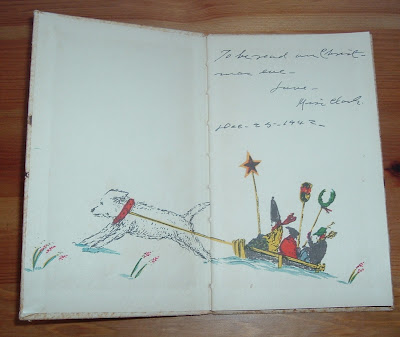
Books and Bidders in the previous post.
Click on the image for an enlarged view.
Digging up interesting fragments among the leaves of new, used, and out-of-print books

 I'm rereading Books and Bidders, by A.S.W. Rosenbach; Little, Brown, and Company, Boston, 1927. Rosenbach was one of the giants of the bibliophile/bookselling world and any bibliophile would enjoy reading about his book exploits.
I'm rereading Books and Bidders, by A.S.W. Rosenbach; Little, Brown, and Company, Boston, 1927. Rosenbach was one of the giants of the bibliophile/bookselling world and any bibliophile would enjoy reading about his book exploits.Books are the final appeal; when the collector is through with the things that decorate his house, he turns to the things that decorate his mind--and these last forever.I like that. A nice collector metaphor applicable to anyone, collector or not, who opens a book and feeds (decorates) his mind.








Assumption #1: The book belonged to Bess and she saved her brother’s letter in this book. If so, she was interested in reading writing and possibly had a desire on some level to write book reviews.Both assumptions have some common ground, but each veers off into dramatically different stories. I’d love to write a story for each, but for now I’ll just give a general overview of what I found and why it’s interesting to me.
Assumption #2: The book belonged to Horace. He was an aspiring book reviewer. He wrote this letter, but never sent it. Maybe because it was too depressing. He stashed it inside one of his books (he evidently read a lot) and forgot about it.
It was so sparkling and refreshing that it was sipping a long cold drink. That Margaret Halsey has a flow of language and the most marvelous gift of pertinent synonym.He goes on to say that although he hasn't had time to read, that doesn't include metaphysics, which he still indulges in, if in an unorthodox way.
I realize we are always in our rightful places, but it is difficult sometimes to understand it.His present employer is having trouble, much like his previous employer, whom he names as Saenger Co., which appears to started business as a chain of theaters for both vaudeville and movies in the early twentieth century.





 I set this book aside last month in advance of the holiday season. As Christmas is "in the air" now, I thought I'd share it here. The Message of the Bells, or What Happened to us on Christmas Eve, was written and illustrated by Hendrick Willem Van Loon, with music by Grace Castagnetta, in 1942. As it's a small, 16-page book, I thought I'd put the whole thing here for anyone to enjoy. An inscription indicates the book was a Christmas gift. The giver may have had the book's subtitle in mind with instructions to read the book on Christmas Eve, 1942. The story and the publication date occurred during World War II. One wonders what special significance Van Loon's tale had for the original owners of this book during a war-time Christmas celebration... or might have for present-day readers with family members fighting in a war overseas?
I set this book aside last month in advance of the holiday season. As Christmas is "in the air" now, I thought I'd share it here. The Message of the Bells, or What Happened to us on Christmas Eve, was written and illustrated by Hendrick Willem Van Loon, with music by Grace Castagnetta, in 1942. As it's a small, 16-page book, I thought I'd put the whole thing here for anyone to enjoy. An inscription indicates the book was a Christmas gift. The giver may have had the book's subtitle in mind with instructions to read the book on Christmas Eve, 1942. The story and the publication date occurred during World War II. One wonders what special significance Van Loon's tale had for the original owners of this book during a war-time Christmas celebration... or might have for present-day readers with family members fighting in a war overseas?
















 UPDATE: Thanks to Ron at famousmormons.net (see comments below), I remembered something I meant to include in this entry. Spencer Adams was the first Mormon to play in the Major Leagues. He played in back-to-back World Series; 1925 for the Washington Senators and 1926 for the New York Yankees. He got to room with Lou Gehrig and Tony Lazzeri. There are a couple of interesting anecdotes in the book I should share.
UPDATE: Thanks to Ron at famousmormons.net (see comments below), I remembered something I meant to include in this entry. Spencer Adams was the first Mormon to play in the Major Leagues. He played in back-to-back World Series; 1925 for the Washington Senators and 1926 for the New York Yankees. He got to room with Lou Gehrig and Tony Lazzeri. There are a couple of interesting anecdotes in the book I should share.